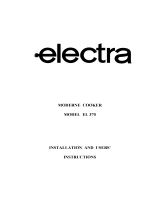
25


Welcome to your new Electra cooker. Its stylish and practical design will enhance your kitchen and make "cooking
electric" a pleasure.
Features include a radiant hob for responsive, economical cooking with two large and two small radiant rings, full
width grill and fan assisted oven and three removable shelves. There is also a clock / timer featuring a minute
minder and automatic oven switching.
Even if you have used an electric cooker before, it is important that you read these instructions thoroughly before
starting to cook, paying particular attention to the installation and safety instructions.
Getting Help If you have any problems with installing or operating your new cooker please contact your
Electricity Company for advice.
For your own safety, make sure that these instructions on installation, use and
maintenance are followed.
IMPORTANT We advise you to keep these instructions in a safe place for future reference.
If you sell or transfer ownership of this product, please pass on these instructions to the
new owner.
1
PREFACE

MODEL NO. EL 230W/I
Voltage: 230/240 Volts AC 50Hz
Wattage: 9.6 / 10.4kW
Height: 1240mm
Width: 460mm
Depth: 585mm
Weight: 51.4kg
This appliance complies with: European Council Directive 73/23/EEC.
EMC Directive 89/336/EEC.
CE Marking Directive 93/68/EEC.
2
TECHNICAL DETAILS

Preface
...........................................................................................
1
Technical Details
.................................................................................
2
Contents
.........................................................................................
3
Safety
.............................................................................................
4
Before Installation ........................................................................... 4
During Operation ............................................................................ 4
After Use ................................................................................... 5
General .................................................................................... 5
Introduction ...................................................................................... 6
Rating Plate ................................................................................ 6
Installation .................................................................................. 6
Reversible Oven Door ....................................................................... 7
General Notes on Using your Cooker ........................................................ 7
About Condensation and Steam ............................................................. 7
Oven Indicator Neon ........................................................................ 7
Grill and Oven Furniture ..................................................................... 7
Getting to Know Your Cooker
....................................................................
8
The Control Panel .......................................................................... 8
The Automatic Timer ............................................................................. 9
The Radiant Hob
................................................................................
12
Recommended Saucepans ................................................................. 12
Hints and Tips ............................................................................. 12
Deep Fat Frying ........................................................................... 12
Preserving ................................................................................. 13
The Grill
.........................................................................................
14
The Grill Pan and Handle ................................................................... 14
Hints and Tips ............................................................................. 14
Grilling Chart .............................................................................. 15
The Fan Oven
...................................................................................
16
Uses of the Fan Oven ...................................................................... 16
Selecting the Fan Oven .................................................................... 16
To Fit the Oven Shelves ................................................................... 16
Hints and Tips ............................................................................. 16
Oven Cooking Chart ....................................................................... 18
Roasting Chart ............................................................................. 19
Defrost Feature .................................................................................. 20
Uses of Defrost Feature .................................................................... 20
Selecting Defrost .......................................................................... 20
Things to Note ............................................................................. 20
Hints & Tips ............................................................................... 20
Care and Cleaning
...............................................................................
21
Cleaning Materials ........................................................................ 21
Cleaning the Outside of the Cooker ........................................................ 21
Cleaning the Hob and Hotplate Trims ...................................................... 21
Cleaning the Grill Deflector, Grill and Oven Furniture ........................................ 21
Cleaning Inside the Oven and Grill Compartments .......................................... 21
Care of Stayclean Surfaces ................................................................ 21
Things to Note ............................................................................ 21
Hints and Tips ............................................................................ 22
Something not Working? ........................................................................ 23
Guarantee ....................................................................................... 24
Service Call Record ............................................................................. 25
3
CONTENTS

THESE WARNINGS ARE PROVIDED IN
THE INTERESTS OF YOUR SAFETY.
ENSURE THAT YOU UNDERSTAND
THEM ALL BEFORE INSTALLING OR
USING THE COOKER.
PLEASE
READ
CAREFULLY
BEFORE INSTALLATION
This cooker is heavy and care must
be taken when moving it.
Ensure that all packaging, both
inside and outside the cooker has
been removed before the cooker is
used.
Do not try to move the cooker by
pulling the door handles.
The electrical installation work must
be undertaken by a qualified
electrician/ competent person.
It is dangerous to alter or modify
the specifications of the cooker in
any way.
After installation, please dispose of
the packaging with due regard to
safety and the environment.
DURING OPERATION
Do not use this cooker if it is in
contact with water and never
operate it with wet hands.
This cooker is designed to be
operated by adults. Young children
must not be allowed to tamper with
the cooker or play with the controls.
Accessible parts especially around
the grill area, may become hot when
the cooker is in use. Children should
be kept away until it has cooled.
Take great care when heating fats
and oils as they will ignite if they
become too hot.
This cooker has been designed for
cooking edible foodstuffs only, and
must not be used for any other
purposes.
Never place plastic or any other
material which may melt in the oven
or on the hob.
Ensure cooking utensils are large
enough to contain foods to prevent
spillages and boil overs.
The handles of saucepans which are
smaller than the heated area on the
hob will become hot. Ensure your
hand is protected before handling the
pan.
Take care to follow the
recommendations given for tending
the food when grilling.
Do not leave the grill pan handle in
position when grilling as it will
become hot.
Always use oven gloves to withdraw
the grill pan, when grilling. Follow the
recommendations on page 14.
4
SAFETY

Ensure that all vents are left
unobstructed to ensure ventilation of
the oven cavity.
Ensure that the anti-tilt shelves are
put in place correctly. Refer to
instructions on pages 16.
Never line any part of the cooker
with aluminium foil.
Always stand back from the cooker
when opening the oven door to allow
any build up of steam or heat to
release.
Do not place sealed cans or
aerosols inside the oven. They may
explode if they are heated.
AFTER USE
Ensure that all control knobs are in
the OFF position when not in use.
For hygiene and safety reasons this
cooker should be kept clean at all
times. A build-up of fats or other
foodstuffs could result in a fire,
especially in the grill pan.
Do not leave utensils containing
foodstuffs, e.g. fat or oil in or on the
cooker in case it is inadvertently
switched ON.
Cookers and hobs become very hot,
and retain their heat for a long period
of time after use. Children should be
kept well away from the cooker until
it has cooled.
GENERAL
Under no circumstances should
repairs be carried out by an
inexperienced person as this may
cause injury or serious malfunction.
This cooker should be serviced by
an authorised Service Engineer and
only genuine-approved spare parts
should be used. Details of repair and
servicing arrangements are supplied
on page 25 of this book.
Do not stand on the cooker or on
the open oven door.
Do not hang towels, dishcloths or
clothes from the cooker or its handle.
They are a safety hazard.
Always switch OFF the cooker at its
power point and allow the cooker to
cool before any maintenance or
cleaning work is carried out.
Only clean this cooker in accordance
with the instructions given in this
book.
5
Your safety is of paramount importance.
Therefore, if you are unsure about any of the
meanings of these WARNINGS contact your
local Electricity Company.

RATING PLATE
Record the model, product and serial numbers inside
the back cover of this instruction book from the rating
plate. This is situated on the lower front frame of the
cooker and can be seen upon opening the oven
door.
The cooker must be protected by a suitably rated
fuse or circuit breaker. The rating of the cooker is
given on the rating plate.
INSTALLATION
If your cooker has been damaged in transit, contact
your supplier immediately. DO NOT attempt to install
it.
Your cooker left the factory fully packaged to protect
it from damage. If it is delivered without packaging
and damage has occurred, the manufacturer cannot
accept responsibility. Contact your supplier for
advice.
Once the packaging has been removed the cooker
should only be moved by hand. DO NOT use a sack
barrow or any other aid to lift the cooker as damage
may occur.
Connection to the electricity supply must be carried
out by a qualified electrician/competent person.
The electrical connection should be made using a
double pole isolating switch (cooker socket) with at
least 3mm contact separation in all poles. The cable
must have conductors of sufficiently high
cross-sectional area to prevent overheating and
deterioration.
Six square millimetres ( 6.00mm² ) is the recommend
cross-section area.
The cable should be routed away from potentially hot
areas marked by an ' X' in the diagram below.
This is a type Y appliance which means it is
free-standing and can be fitted with cabinets on one
or both sides. It may also be fitted in a corner
setting.
Side walls which are above hob level should be
protected by heat resistant non-combustible material
and MUST NOT be nearer than 40mm to the hob
side.
A nominal air gap of 10mm at the sides of the cooker
is required to enable the cooker to be moved into
position.
Overhanging surfaces or a cooker hood should be a
minimum of 685mm above the hob.
It is important to ensure that the appliance is level
after installation. Levelling feet are fitted to the front
of the appliance to accommodate uneven floors.
To move the cooker, open the oven door, and lift the
cooker by holding inside the top of the oven
compartment.
6
WARNING: THIS COOKER MUST BE EARTHED
INTRODUCTION
ed

REVERSIBLE OVEN DOOR
If you require the oven door to be hinged on the
opposite side, you will need to contact your local
Electricity Company's Service Department. PLEASE
NOTE that a charge may be made.
GENERAL NOTES ON USING YOUR
COOKER
We suggest that you run the oven elements for 10 -
15 minutes at 220°C to burn off any residue from
their surfaces.
The procedure should be repeated with the grill for
approximately 5 - 10 minutes.
During this period an odour may be emitted, it is
therefore advisable to open a window for ventilation.
ABOUT CONDENSATION AND STEAM
When food is heated it produces steam similar to a
boiling kettle. The ovens are vented to allow some of
this steam to escape. However, always stand back
from the cooker when opening the oven door to allow
any build up of steam or heat to release.
If the steam comes into contact with a cool surface
on the outside of the cooker, e.g. a trim, it will
condense and produce water droplets. This is quite
normal and is not caused by a fault on the cooker.
To prevent discolouration, regularly wipe away
condensation and also soilage from surfaces.
For your safety wall coverings at the rear of the
appliance should be securely fixed to the wall.
OVEN INDICATOR NEON
This light indicates whether the oven is switched on.
It also indicates when the set temperature has been
reached. It will turn on and off during use to show
that the temperature is being maintained.
GRILL AND OVEN FURNITURE
The following items of grill/oven furniture have been
supplied with the cooker.
1 grill pan
1 grill pan handle
1 grill pan grid
1 grill deflector
3 straight shelves
for oven cooking
Scuffing of the Stayclean oven coating by the oven
furniture pack may occur during transit. These marks
will disappear after the oven elements have been
burnt off for the first time.
7

THE CONTROL PANEL
FEATURES
A - Hotplate Controls
B - Grill Control
C - Oven Indicator Neon
D - Oven Temperature Control
E - Automatic Timer
8
GETTING TO KNOW YOUR COOKER
A B C D E

\
A START TIME SETTING KNOB
B SECOND HAND
C CLOCK SYMBOL
D CLOCK/MINUTE MINDER/LENGTH
OF COOKING TIME SETTING KNOB
E START TIME INDICATOR
F HOUR HAND
G DISPLAY WINDOW
H MANUAL SYMBOL
J MINUTE HAND
1. TO SET THE TIME OF DAY
The clock will operate when the cooker is
switched ON at the wall.
To set, pull out and turn setting knob (D)
clockwise until the right time of day is displayed,
e.g. 9 a.m. as Fig.1.
2. TO SET FOR MANUAL COOKING
Ensure the time of day has been set as above.
Push in and turn setting knob (A) in either
direction until the start time indicator (E) lines up
with the hour hand of the clock.
Push in and turn setting knob (D) clockwise until
the manual symbol (H) can be seen in window
(G) as Fig. 2.
The oven temperature control can now be
operated as required. The oven neon indicator
will glow.
3. TO SET THE MINUTE MINDER
Turn setting knob (D) clockwise, without pulling
it out. The selected minutes can be seen in the
window (G), e.g. 80 minutes as Fig. 3.
A period of up to 3 hours can be timed using the
minute minder. The minute minder cannot be
used when an automatic programme has been
set on the oven timer.
At the end of the set time a continuous buzzer
will sound for up to 6 minutes.
9
THE AUTOMATIC TIMER
B
C
D
J
H
G
E F
A
Fig. 1
D
Fig. 2
A
D
H
G
Fig. 3
G
D
80
90
70

4. TO CANCEL MINUTE MINDER/BUZZER
Turn setting knob (D) clockwise, without pulling
it out until "O" or the manual symbol appears in
the window (G) as Fig.4.
5. HOW TO SET THE OVEN TIMER
When using the oven timer for the very first time,
it is advisable to let it operate while you are at
home. The timer can be checked to show that it
is operating correctly and then you will then feel
confident to leave a meal to cook automatically in
the future.
A) TO SWITCH THE OVEN ON AND OFF
AUTOMATICALLY
i) Make sure the electricity supply is switched
ON.
ii) Check the clock shows the right time of day
and the cooker is set in manual (see point 2).
Adjust as necessary as Fig. 5.
iii) Place food in oven.
iv) To set the length of time you want the food to
cook; turn setting knob (D) clockwise,
without pulling it out, until the required
cooking period can be seen in the window (G)
e.g. 160 minutes (2 hours 40 mins) as Fig. 6.
v) Set the start time, by pushing in and turning
setting knob (A) in either direction until
indicator (E) lines up with the time you want
the food to start cooking, e.g. 1.30 p.m. as
Fig. 7.
vi) Turn the oven temperature control to the
required setting. The oven indicator neon
should be OFF.
vii)When automatic cooking starts the oven
indicator neon will turn ON and OFF showing
that the oven temperature is being
maintained.
viii)The start time indicator (E) will move with the
hour hand of the clock until the length of
cooking time is complete. A buzzer will sound
which can be cancelled by following point 4 as
Fig. 8.
ix) The maximum cooking time on automatic is 3
hours.
10
Fig. 4
G
D
Fig. 5
G
D
A
H
D
G
150
160
170
Fig. 6
Fig. 7
G
A
E
150
160
170
Fig. 8
G

B) TO START COOKING NOW, THEN SWITCH
OFF AUTOMATICALLY
Follow the first 3 points under section 5. (A)
above, and then;
iv) To set the length of time you want the food to
cook; turn setting knob (D) clockwise,
without pulling it out, until the required
cooking period can be seen in window (G),
e.g. 120 minutes (2 hours) and Fig. 9.
v) Turn the oven temperature control to the
required setting. The oven indicator neon
should glow.
vi) The oven indicator neon will turn ON and OFF
showing that the oven temperature is being
maintained.
vii)The start time indicator (E) will move with the
hour hand of the clock until the length of
cooking time is complete. A buzzer will sound
which can be cancelled by following point 4 as
Fig. 10.
6. RETURNING THE COOKER TO
MANUAL OR TO CANCEL AN
AUTOMATIC PROGRAMME
Turn the oven temperature control OFF. Ensure
the start time indicator (E) lines up with the hour
hand of the clock by pushing in and turning in
either direction, setting knob (A). Fig. 11.
The manual symbol (H) should be displayed in
window (G) by turning setting knob (D) clockwise.
Turn the oven temperature control ON to check
that the oven operates manually. The oven neon
indicator should light.
7. THINGS TO NOTE
* If an automatic programme has been set on
the oven, the grill WILL operate manually.
* The delay time plus the cooking time MUST
NOT exceed 11 hours and 59 minutes.
11
G
D
120
130
110
Fig. 9
Fig. 10
G
Fig. 11
D
A
H

To operate the hotplates, turn the control knobs
clockwise from the OFF position to the required
setting.
The highest number represents the hottest
setting and the lowest number the coolest
setting. Choose a setting appropriate to the
quantity and type of food to be cooked.
RECOMMENDED SAUCEPANS
For speed and economy only good quality
saucepans with flat bases and close fitting lids are
recommended.
The saucepan base should cover the hotplate as
much as possible. A base diameter of up to 225mm
(9") may be used on a 180mm (7") hotplate.
Pressure cookers, preserving pans, etc., should
comply with the recommendations given above.
Traditional round bottomed Woks must not be used
even with a stand. Woks with flat-bottomed bases
are available and do comply with the above
recommendations.
HINTS AND TIPS
Lift, rather than slide saucepans on and off the
hotplates. This will help to reduce scratches and
maintain the efficiency of the hotplate.
Avoid placing fish kettles or large preserving
pans across two hotplates as this may cause
damage.
Follow any guidelines provided by the saucepan
manufacturer, particularly those relating to
recommended heat settings.
To prolong the life of the hotplates:-
Never use utensils with a skirt, e.g. a bucket.
Never use an asbestos mat.
Never line the spillage tray with aluminium foil
Never leave the hotplates ON when not
covered with a saucepan.
DEEP FAT FRYING
SPECIAL FRYING NOTE:
For safety purposes when deep fat frying, fill the pan
one-third full of oil, DO NOT cover the pan with a lid
and DO NOT leave the pan unattended. In the
unfortunate event of a fire, switch the cooker OFF at
the electricity supply and cover the pan with a lid or
damp cloth to assist in smothering the flames.
DO NOT use water on the fire. Leave the pan to cool
for at least 30 minutes before moving it.
DO NOT leave the fat or oil in the frying pan on the
hob to store it in case the hob is inadvertently
switched ON.
12
USING THE HOB
THE RADIANT HOB

1. Preparing the food.
Seal the food by coating with flour, egg and
breadcrumbs or batter. Do not use a basket with
batter coated foods as they will stick.
2. Amount of oil.
For safety purposes fill the pan only one-third full
of oil.
3. Testing the temperature of the oil.
It is advisable to use a thermometer to test the
temperature of the oil. Alternatively, drop a small
cube of bread into the oil which should brown in
just under a minute if the oil is at the correct
temperature of 190°C/375°F.
4. Cooking the food.
Lower the food gently into the oil. Do not add too
much food at once or the temperature of the oil
will be reduced and may result in soggy, greasy
food.
Turn the food if necessary; doughnuts float to the
surface so will not brown on the upperside if not
turned. Once cooked, drain the food on
absorbent paper.
5. Double frying chips.
Double frying will ensure good chips. First fry the
chips for a few minutes at 170°C/340°F to seal
the outside. Remove the chips from the oil.
Increase the temperature of the oil to
190°C/375°F to finish cooking and brown the
chips.
Chips may be kept for several hours after the first
frying before finishing off with the second frying.
6. Frying temperatures
Celsius Fahrenheit
Scale (
o
C) Scale (
o
F)
150 300
First frying of potatoes 170 340
175 350
180 360
Second frying of potatoes 190 375
Frying chicken and fish 195 380
200 390
PRESERVING
1. DO NOT use a pan that overlaps the perimeter of
the hob trim.
2. To allow for a full rolling boil, the pan should be
no more than one third full when all the
ingredients have been added. It is better to use
two pans rather than overfill one, or use half
quantities.
3. Use firm fruit or vegetables and wash well before
using.
4. Preserving sugar gives clear jam, however
granulated sugar is cheaper and gives equally
good flavour.
5. Crystallization may be caused if sugar is not
completely dissolved before bringing jam to the
boil. Over boiling will affect the flavour, setting
properties and colour of the jam.
6. To test jam for setting:
If a jam thermometer is available, boil jam to
104°C. Marmalade should be boiled to 106°C.
If a jam thermometer is not available, remove
pan from heat, place sample of jam on a cold
dish and cool quickly (i.e. in a freezer or frozen
food storage compartment of a refrigerator).
When cold, it will crinkle and hold the mark of a
finger run through it, if it is ready.
7. The scum should be removed as soon as
possible after setting point has been reached.
Marmalade should be allowed to cool before
potting to prevent the peel rising.
13

To operate the grill, turn the grill control
clockwise from the 'OFF' position to the
required setting.
The highest number represents the hottest
setting and the lowest the coolest setting.
NOTE
THE GRILL DOOR MUST BE LEFT OPEN DURING
GRILLING.
THE GRILL PAN AND HANDLE
The grill pan is supplied with a removable handle.
To insert the handle, press the button on the handle
with the thumb and pivot the handle slightly upwards
inserting the lip into widest part of the bracket. Move
the handle towards the left, lower into position and
release the button.
Ensure the handle is positively located.
When removing the handle, press the button on the
handle with the thumb and pivot the handle slightly
upwards and towards the right to remove from the
bracket.
Ensure your hand is protected with an oven
glove when removing the grill pan handle as the
grill element can become very hot.
ALWAYS REMOVE THE GRILL PAN HANDLE
DURING GRILLING.
To correctly locate the grill pan ensure the pan
locates into the runners in the grill compartment side
panels. There are two grilling positions.
To check the progress of the food being grilled, the
grill pan should be withdrawn on the runners to
attend to food during cooking or the grill pan can be
lifted away from the cooker and rested on a heat
resistant work surface.
HINTS AND TIPS
Food should be thoroughly dried before
grilling to minimise splashing. Brush lean
meats and fish lightly with a little oil or melted
butter to keep them moist during cooking.
Adjust the height of the grilling grid and grill
pan runner position to allow for different
foods.
14
CAUTION - ACCESSIBLE PARTS MAY BECOME HOT WHEN THE GRILL IS IN USE. CHILDREN SHOULD BE
KEPT AWAY.
THE GRILL

When toasting bread use the top runner position.
Adjust the grill pan grid to suit.
Accompaniments such as tomatoes and
mushrooms may be placed underneath the grid
when grilling meats.
Preheat the grill on a full setting for a few
minutes before cooking. Adjust the heat setting
and runner position as necessary during cooking.
The food should be turned over during cooking
as required.
GRILLING CHART
FOOD RUNNER
POSITION
GRILL TIME
(mins in total)
Bacon Rashers
Beefburgers
Chicken Joints
Chops - Lamb
Pork
Fish - Whole
Trout/Mackerel
Fillets - Plaice/Cod
Kebabs
Kidneys - Lamb/Pig
Liver - Lamb/Pig
Sausages
Steaks - Rare
Medium
Well Done
Toasted Sandwiches
2
2
2
2
2
2
2
2
2
2
2
2
2
2
2
2
5-6
10-15
30-40
15-20
20-30
15-25
10-15
20-30
8-12
10-20
20-30
6-12
12-16
14-20
3-4
Runner positions are counted from the bottom
upwards.
The times quoted above are given as a guide and
should be adjusted to suit personal taste.
Adjust the grill pan grid to suit the type and thickness
of food to be cooked.
15

To operate the oven turn the oven temperature
control to the required setting.
The oven indicator neon will glow until the oven
has reached the required temperature and then
go out.
It will turn ON and OFF periodically during
cooking showing that the temperature is being
maintained.
TO FIT THE OVEN SHELVES
The shelves should be fitted with the straight rods
uppermost on the frame and the forms towards the
back of the oven. If not fitted correctly the anti-tilt and
safety stop mechanism will be affected.
HINTS AND TIPS
Arrange the shelves in the required positions
before switching the oven ON. Shelves are
numbered from the bottom upwards.
When cooking more than one dish in the fan
oven, place dishes centrally on different shelves
rather than cluster several dishes on one shelf.
This will allow the heat to circulate freely for the
best cooking results.
When batch baking one type of food, e.g. Victoria
sandwich cakes, those of similar size will be
cooked in the same time.
16
USES OF THE FAN OVEN
PREHEATING
The fan oven quickly reaches its temperature, so it is not usually necessary to preheat the oven. Without
preheating, however, you may find you need to add an extra 5 - 10 minutes on the recommended cooking times.
For recipes needing high temperatures, e.g. bread, pastries, scones, soufflés, etc., best results are achieved if the
oven is preheated first.
COOKING TEMPERATURES
Fan oven cooking generally requires lower temperatures than conventional cooking. Follow the temperatures
recommended in the charts on pages 18 & 19. As a guide reduce temperatures by about 20°C - 25°C for your own
conventional oven recipes.
BATCH BAKING
The fan oven cooks evenly on all shelf levels, especially useful when batch baking.
SELECTING THE FAN OVEN
16
THE FAN OVEN

It is recommended that when baking larger
quantities, the shelf positions should be evenly
spaced to suit the load being cooked. A slight
increase in cooking time may be necessary.
Do not place dishes or baking trays directly on
the oven floor as it interferes with the oven air
circulation and can lead to base burning; use the
lower shelf position. However non critical dishes
can be placed on the oven base when more
space is required.
The use of excessively high temperatures can
cause uneven browning. It may be necessary to
reduce temperatures slightly. Refer to the
recommendations given in the oven cooking
chart on page 18.
17

The oven temperatures are intended as a guide only. It may be necessary to increase or decrease the temperature
by 10°C to suit individual preferences and requirements.
FAN OVEN
FOOD SHELF
POSITION
COOKING
TEMP °C
Biscuits
Bread
Bread rolls/buns
Cakes: Small & Queen
Sponges
Victoria Sandwich
Madeira
Rich Fruit
Christmas
Gingerbread
Meringues
Flapjack
Shortbread
Casseroles: Beef/lamb
Chicken
Convenience Foods
Fish
Fish Pie (Potato Topped)
Fruit Pies, Crumbles
Milk Puddings
Pasta, Lasagne etc.
Pastry: Choux
Eclairs,Profiteroles
Flaky/Puff Pies
Shortcrust Mince Pies
Meat Pies
Quiche,Tarts,Flans
Patés and Terrines
Roasting Meat, Poultry
Scones
Shepherd's Pie
Soufflés
Vegetables:
Roast Potatoes
Stuffed Marrow
Stuffed Tomatoes
Yorkshire Puddings:Large
Individual
Shelf
positions
are not
critical
but ensure
that oven
shelves are
evenly
spaced
when more
than one is
used
180-190
200-220
200-220
160-170
160-170
160-170
140-150
130-140
130-140
140-150
80-100
170-180
130-140
140-160
180-190
170-190
190-200
190-200
130-140
190-200
190-200
170-180
210-220
190-200
190-210
180-210
150-160
160-180
210-220
190-200
170-180
180-190
180-190
180-190
180-190
210-220
200-210
1818
OVEN COOKING CHART
Follow manufacturer's instructions
Page is loading ...
Page is loading ...
Page is loading ...
Page is loading ...
Page is loading ...
Page is loading ...
Page is loading ...
Page is loading ...
-
 1
1
-
 2
2
-
 3
3
-
 4
4
-
 5
5
-
 6
6
-
 7
7
-
 8
8
-
 9
9
-
 10
10
-
 11
11
-
 12
12
-
 13
13
-
 14
14
-
 15
15
-
 16
16
-
 17
17
-
 18
18
-
 19
19
-
 20
20
-
 21
21
-
 22
22
-
 23
23
-
 24
24
-
 25
25
-
 26
26
-
 27
27
-
 28
28
Electra Accessories EL230 User manual
- Type
- User manual
- This manual is also suitable for
Ask a question and I''ll find the answer in the document
Finding information in a document is now easier with AI
Related papers
Other documents
-
Tricity Bendix SIE250W User manual
-
 Tricity Bendix RE50M User manual
Tricity Bendix RE50M User manual
-
AEG B600TGW User manual
-
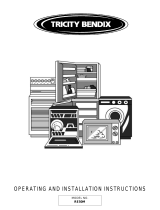 Tricity Bendix RE50MW User manual
Tricity Bendix RE50MW User manual
-
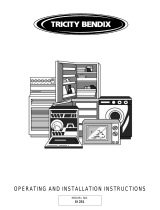 Tricity Bendix SI 251 User manual
Tricity Bendix SI 251 User manual
-
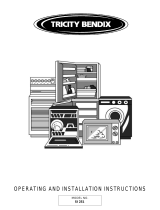 Tricity Bendix Si251 User manual
Tricity Bendix Si251 User manual
-
 Tricity Bendix CSi2400 User manual
Tricity Bendix CSi2400 User manual
-
 Tricity Bendix CSI 2400 User manual
Tricity Bendix CSI 2400 User manual
-
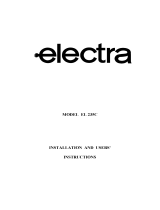 Tricity Bendix EL235C User manual
Tricity Bendix EL235C User manual
-
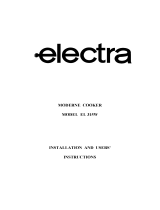 Tricity Bendix EL315 User manual
Tricity Bendix EL315 User manual





























